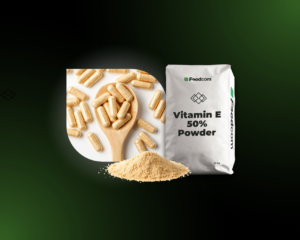- Vitamin E: Following the explosion at BASF’s Ludwigshafen plant, production of vitamin E has been halted, which could lead to higher prices, especially in the animal nutrition sector.
- L-theanine: Growing interest in mental health and sleep supplements is driving demand for L-theanine, underscoring the stability of the supply chain.
- Choline chloride: Demand for feed additives in the poultry and aquaculture sectors is growing, driving up prices, especially in North America and Europe.
Welcome to Partners!
Welcome back to our newsletter!
In the latest edition of the newsletter, we look at important developments in the raw materials and nutrients market. As a result of the explosion at the BASF plant in Ludwigshafen, vitamin E production has been severely disrupted, threatening to increase prices and destabilise the market, particularly in the animal nutrition sector. Meanwhile, growing interest in natural methods of supporting mental health and sleep is driving global demand for L-theanine, and the stability of supply chains is becoming crucial to maintaining production quality. In turn, the choline chloride market is seeing increasing demand for feed additives, which is impacting prices in North America and Europe.
Let’s take a look at what else is happening in the market!
PRODUCTS OF THE WEEK
Vitamin E
BASF’s production of vitamin E was disrupted by an explosion at the Ludwigshafen plant in July 2024. Repairs are underway and production is not expected to resume until January 2025 at the earliest. The shortage is expected to increase vitamin E prices, affecting animal nutrition and overall market stability. This situation is similar to the 2017 incident, which led to a significant increase in vitamin prices.
L-theanine
In August and September 2024, the L-theanine market experienced steady growth, driven by increasing consumer interest in natural supplements to relieve stress and improve cognitive function. Global demand for L-theanine continued to grow, particularly in the wellness, mental health and sleep aid sectors, as more consumers sought alternatives to pharmaceutical options. Supply chain stability remained key, as manufacturers focused on maintaining high quality production to meet growing demand
Choline chloride
In August and September 2024, the choline chloride market continued to see demand from the animal feed sector, driven by increasing demand for feed additives for poultry, pigs and aquaculture. Supply chain challenges and fluctuations in the cost of raw materials, particularly ethylene oxide and trimethylamine, affected prices, with moderate price increases in North America and Europe due to limited stocks. The pharmaceutical and human nutrition sectors also contributed to increased demand, particularly for brain and liver health supplements.
NEWS
Falling paraffin prices and hurricane-related supply disruptions affect US refining market
Refinery production in the US remained strong, averaging 16.9 million barrels per day. However, the hurricane season, in particular Hurricane Beryl, disrupted MTBE supplies, affecting export restrictions. Infrastructure damage and delays at key terminals further exacerbated availability problems. Although domestic refinery demand has declined, strong global demand, particularly from Asia, has kept MTBE prices at favourable levels. Pressure on prices is expected to continue in the autumn, due to logistical problems and limited supply.
Indian styrene copolymer prices see a moderate decline, while the market remains stable in August 2024
In August 2024, the Indian styrene copolymer market recorded a price decline of 1.3% compared to July, mainly due to lower demand in the automotive and electronics sectors and a seasonal slowdown in production. Importers and domestic producers adjusted their strategies accordingly, keeping supply in balance. Despite rising raw material prices in Europe, Indian manufacturers have benefited from cheaper supplies from Asia. Demand is expected to pick up once the monsoon season ends, which could result in moderate price increases in the coming months.
![Commodity market turmoil: Vitamin E, L-theanine and choline chloride [59th Edition ADDITIVES Newsletter] Commodity market turmoil: Vitamin E, L-theanine and choline chloride [59th Edition ADDITIVES Newsletter]](https://foodcom.pl/wp-content/uploads/2023/08/Foodcom_SA_Newsletter_Additives-1520x760.jpg)






